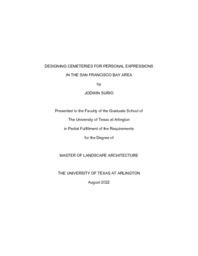
ATTENTION: The works hosted here are being migrated to a new repository that will consolidate resources, improve discoverability, and better show UTA's research impact on the global community. We will update authors as the migration progresses. Please see MavMatrix for more information.
Show simple item record
| dc.contributor.advisor | Jones Allen, Diane | |
| dc.contributor.advisor | Allen, Austin | |
| dc.creator | Surio, Jodwin | |
| dc.date.accessioned | 2022-09-15T14:02:23Z | |
| dc.date.available | 2022-09-15T14:02:23Z | |
| dc.date.created | 2022-08 | |
| dc.date.issued | 2022-08-15 | |
| dc.date.submitted | August 2022 | |
| dc.identifier.uri | http://hdl.handle.net/10106/30978 | |
| dc.description.abstract | Our country’s largest cities have become more racially and ethnically diverse than they were in 2010 (US News, 2020). Differences are present and yet, our cemeteries, originally catering to a predominantly Caucasian market (Sloane, 1991), remain Eurocentric in design (Jones, 2011). The purpose of this master’s design thesis is to determine the design principles and elements necessary for a cemetery that is transformed by the personal expressions exhibited by visitors after the day of burial. The study focuses specifically on cemeteries in the San Francisco Bay Area. The findings were used to develop a new kind of cemetery typology that aims to have cemetery design be led by behavior, activities, rituals, and traditions of its users rather than being led solely by the personal and business preferences of cemetery designers and professionals.
This study utilizes qualitative research methods (Sommer & Sommer, 2002) beginning with a literature review to see what issues may be addressed by this study and to gain insight on how to improve cemetery design (Sommer & Sommer, 2002). Data collection began with initial site visits to cemeteries that included notes derived from photo documentation and casual observation (Sommer & Sommer, 2002). Case study sites were then selected from these initial visits to conduct systematic observations in using tally sheets and ethnograms/observation sheets (Sommer & Sommer, 2002).
Adopting the case study pattern used by Marcus and Francis in their book, People Places (Marcus & Francis, 1998), the gathered data was analyzed and synthesized to reveal insights on the successful and unsuccessful features in cemetery design as it relates to personal expressions, sufficiently informing the researcher in developing the final non-sectarian cemetery design (Simonds & Starke, 2006) adapted for the city of Oakland.
The design concludes the study and addresses the findings on the design features and elements that conflict with personal expressions such as lack of delineation, missing features and elements for a gathering space, conflicting rules, and inaccessibility. The design also reflects the design features and elements that encourage personal expression such as the gravestones designed as and for personal expression, vertical elements, and personal maintenance.
The knowledge produced from this research contributes to the field as it aids landscape architects in creating inclusive cemeteries that encourage personal expression of its users. These landscapes have the potential of not just ameliorating the pain of death, but also providing the opportunity for cultural preservation and meaning. | |
| dc.format.mimetype | application/pdf | |
| dc.language.iso | en_US | |
| dc.subject | Cemeteries | |
| dc.subject | Personal expression | |
| dc.subject | Culture | |
| dc.subject | Cultural | |
| dc.subject | Healing landscapes | |
| dc.subject | Landscape design | |
| dc.subject | Landscape architecture | |
| dc.subject | Cemetery design | |
| dc.subject | San Francisco | |
| dc.subject | Bay area | |
| dc.subject | Oakland | |
| dc.subject | Inclusion | |
| dc.subject | Inclusive | |
| dc.title | Designing Cemeteries for Personal Expressions in the San Francisco Bay Area | |
| dc.type | Thesis | |
| dc.degree.department | Landscape Architecture | |
| dc.degree.name | Master of Landscape Architecture | |
| dc.date.updated | 2022-09-15T14:02:23Z | |
| thesis.degree.department | Landscape Architecture | |
| thesis.degree.grantor | The University of Texas at Arlington | |
| thesis.degree.level | Masters | |
| thesis.degree.name | Master of Landscape Architecture | |
| dc.type.material | text | |
| dc.creator.orcid | 0000-0003-3712-5061 | |
Files in this item
- Name:
- SURIO-THESIS-2022.pdf
- Size:
- 26.87Mb
- Format:
- PDF
This item appears in the following Collection(s)
Show simple item record


